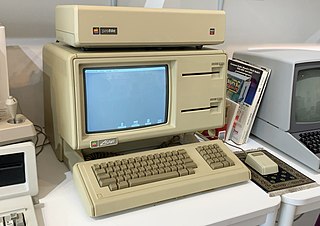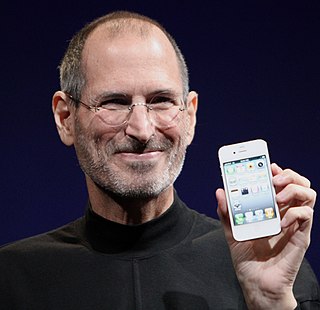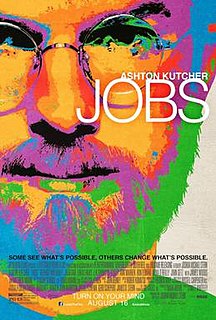Related Research Articles

Stephen Gary Wozniak, also known by his nickname "Woz", is an American electronics engineer, computer programmer, philanthropist, inventor, and technology entrepreneur. In 1976, with business partner Steve Jobs, he co-founded Apple Computer, which later became the world's largest technology company by revenue and the largest company in the world by market capitalization. Through his work at Apple in the 1970s and 1980s, he is widely recognized as one of the most prominent pioneers of the personal computer revolution.

Lisa is a desktop computer developed by Apple, released on January 19, 1983. It is one of the first personal computers to present a graphical user interface (GUI) in a machine aimed at individual business users. Its development began in 1978. It underwent many changes before shipping at US$9,995 with a five-megabyte hard drive. It was affected by its high price, insufficient software, unreliable Apple FileWare floppy disks, and the immediate release of the cheaper and faster Macintosh. Only 10,000 were sold in two years.

Jef Raskin was an American human–computer interface expert best known for conceiving and starting the Macintosh project at Apple in the late 1970s.

John Sculley III is an American businessman, entrepreneur and investor in high-tech startups. Sculley was vice-president (1970–1977) and president of PepsiCo (1977–1983), until he became chief executive officer (CEO) of Apple Inc. on April 8, 1983, a position he held until leaving in 1993. In May 1987, Sculley was named Silicon Valley's top-paid executive, with an annual salary of US$10.2 million.

Pirates of Silicon Valley is a 1999 American biographical drama television film directed by Martyn Burke and starring Noah Wyle as Steve Jobs and Anthony Michael Hall as Bill Gates. Spanning the years 1971–1997 and based on Paul Freiberger and Michael Swaine's 1984 book Fire in the Valley: The Making of the Personal Computer, it explores the impact that the rivalry between Jobs and Gates (Microsoft) had on the development of the personal computer. The film premiered on TNT on June 20, 1999.

Andrew Jay Hertzfeld is an American software engineer and innovator who was a member of the original Apple Macintosh development team during the 1980s. After buying an Apple II in January 1978, he went to work for Apple Computer from August 1979 until March 1984, where he was a designer for the Macintosh system software. Since leaving Apple, he has co-founded three companies: Radius in 1986, General Magic in 1990, and Eazel in 1999. In 2002, he helped Mitch Kapor promote open source software with the Open Source Applications Foundation. Hertzfeld worked at Google from 2005 to 2013, where in 2011, he was the key designer of the Circles user interface in Google+.

The Apple Macintosh—later rebranded as the Macintosh 128K—is the original Apple Macintosh personal computer. It played a pivotal role in establishing desktop publishing as a general office function. The motherboard, a 9 in (23 cm) CRT monitor, and a floppy drive were housed in a beige case with integrated carrying handle; it came with a keyboard and single-button mouse. It sold for US$2,495. The Macintosh was introduced by a television commercial entitled "1984" shown during Super Bowl XVIII on January 22, 1984 and directed by Ridley Scott. Sales of the Macintosh were strong from its initial release on January 24, 1984, and reached 70,000 units on May 3, 1984. Upon the release of its successor, the Macintosh 512K, it was rebranded as the Macintosh 128K. The computer's model number was M0001.
Burrell Carver Smith is an American engineer who, while working at Apple Computer, designed the motherboard for the original Macintosh. He was Apple employee #282, and was hired in February 1979, initially as an Apple II service technician. He also designed the motherboard for Apple's LaserWriter.
Reality distortion field (RDF) is a term first used by Bud Tribble at Apple Computer in 1981, to describe company co-founder Steve Jobs' charisma and its effects on the developers working on the Macintosh project. Tribble said that the term came from Star Trek, where in the episode "The Menagerie", it was used to describe how the aliens created their own new world through mental force.
Armas Clifford "Mike" Markkula Jr. is an American electrical engineer, businessman and investor. He was the original angel investor, first chairman, and second CEO for Apple Computer, Inc., providing critical early funding and managerial support. At the company's founding, Markkula owned 26% of Apple, equivalent to each of the shares owned by cofounders Steve Jobs and Steve Wozniak.
Guy L. "Bud" Tribble is Vice President of Software Technology at Apple Inc.

Apple Inc., formerly Apple Computer, Inc., is a multinational corporation that creates consumer electronics, personal computers, servers, and computer software, and is a digital distributor of media content. The company has a chain of retail stores known as Apple Stores. Apple's core product lines are the iPhone smartphone, iPad tablet computer, and Macintosh computer line. Founders Steve Jobs, Steve Wozniak, and Ronald Wayne created Apple Computer Co. on April 1, 1976, to market Wozniak's Apple I desktop computer, and Jobs and Wozniak incorporated the company on January 3, 1977, in Cupertino, California.
Joanna Karine Hoffman is an American marketing executive. She was one of the original members of both the Apple Computer Macintosh team and the NeXT team. At the time she began at Apple Computer, the Mac was "still a research project". Her position "constituted the entire Macintosh marketing team for the first year and a half of the project," which included Product Marketing collaboration on the Mac product design itself. She also wrote the "first draft of the Macintosh User Interface Guidelines." Hoffman would eventually run the International Marketing Team which brought the Mac to Europe and Asia.

The Little Kingdom: The Private Story of Apple Computer is the first book that documented the development of Apple Computer. It was published in 1984 and written by then-Time Magazine reporter Michael Moritz. While Steve Jobs initially cooperated with Moritz, he ended communication in the middle of the project and did not authorize the published final version. Moritz reissued an updated version of the book in 2009 as Return to the Little Kingdom: Steve Jobs, the Creation of Apple, and How It Changed the World.

Steven Paul Jobs was an American entrepreneur, industrial designer, business magnate, media proprietor, and investor. He was the co-founder, chairman, and CEO of Apple; the chairman and majority shareholder of Pixar; a member of The Walt Disney Company's board of directors following its acquisition of Pixar; and the founder, chairman, and CEO of NeXT. He is widely recognized as a pioneer of the personal computer revolution of the 1970s and 1980s, along with his early business partner and fellow Apple co-founder Steve Wozniak.

Daniel Kottke is an American businessman known for being a college friend of Steve Jobs and one of the first employees of Apple Inc.

Jobs is a 2013 American biographical drama film based on the life of Steve Jobs, from 1974 while a student at Reed College to the introduction of the iPod in 2001. It is directed by Joshua Michael Stern, written by Matt Whiteley, and produced by Stern and Mark Hulme. Steve Jobs is portrayed by Ashton Kutcher, with Josh Gad as Apple Computer's co-founder Steve Wozniak. Jobs was chosen to close the 2013 Sundance Film Festival.

Revolution in the Valley: The Insanely Great Story of How the Mac Was Made is a nonfiction book written by Andy Hertzfeld about the birth of the Apple Macintosh personal computer. The author was a core member of the team that built the Macintosh system software and the chief creator of the Mac's radical new user interface software. The book is a collection of anecdotes tracing the development of the Macintosh from a secret project in 1979 through its "triumphant introduction" in 1984. These anecdotes were originally published on the author's Folklore.org web site.

Through the Looking Glass, also known as Alice, was a 1984 video game written for the Apple Lisa and Apple Macintosh computers. Written by a member of the Lisa and Mac teams, Steve Capps, it was one of the earliest video games on the Mac platform, part of the only games disk officially sold by Apple Computer during that era.

Scottyite is a barium copper silicate. It was named for Michael Scott, first CEO of Apple. Its type locality is the Wessels mine, Northern Cape, South Africa, where it was first identified. It has also been found at several localities in the Rhineland-Palatinate.
References
- ↑ Isaacson, Walter (2011). Steve Jobs .
[Mike] Markkula [born February 11, 1942] and Scott...shared the same birthday, which they celebrated together each year. At their birthday lunch in February 1977, when Scott was turning thirty-two...
- ↑ Berlin, Leslie (2017). Troublemakers : Silicon Valley's Coming of Age (1st ed.). New York. p. 50. ISBN 978-1-4516-5150-8. OCLC 1008569018.
- ↑ Hertzfeld, Andy (October 1980). "Macintosh stories: Good Earth". Folklore.org.
- ↑ Hertzfeld, Andy (February 1981). "Macintosh stories: Black Wednesday". Folklore.org.
- ↑ Seibold, Chris (July 10, 2011). "July 10, 1981: Michael Scott Leaves Apple". AppleMatters.com.
- ↑ Linzmayer, pg 17
- ↑ "Sponsor and contributors (Michael Scott)".
- ↑ "Rruffite". Mindat.org. Retrieved March 10, 2012.
- ↑ "Scottyite". Mindat.org. Retrieved August 31, 2012.
